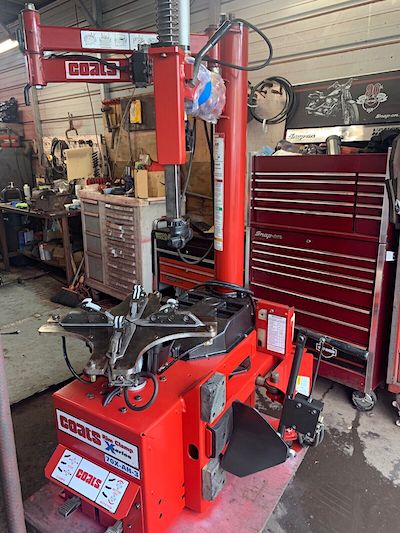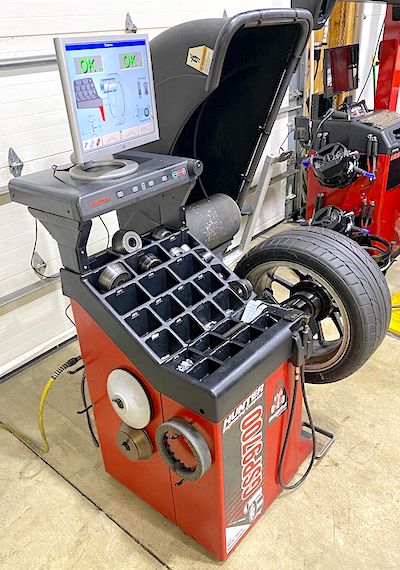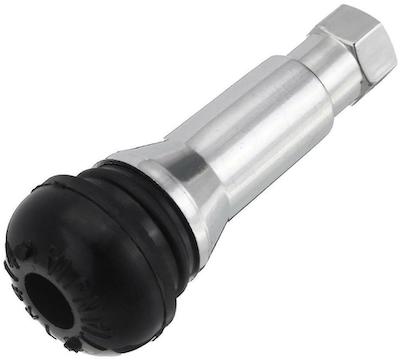To ensure your vehicle runs as intended, having the vehicle tires mounted and balanced is integral to the installation. The cost of mounting and balancing tires varies, depending on several factors, such as the type of vehicle you drive and where you have the work performed. On average, you may spend $15 to $60 per tire.
What Is Tire Mounting?
The term “tire mounting” simply means putting the tires on the wheels and then installing the wheels on the vehicle. This service occurs whenever you buy new tires or you need to have the tire remounted after a repair.

Coats Rim Force tire changer
When you buy new tires and have them installed, the technician will mount the tires following the following steps:
- Wheels are removed from the vehicle.
- A tire changer is used to take the old rubber off the rim.
- A new tire is installed, along with a new valve.
- The tire is inflated to recommended air pressure (psi).
- After balancing, the wheel and tire are placed back on the vehicle.
- The technician tightens the lug nuts to secure the wheel.
If you have the right equipment, you can mount your own tires. For the cost, it usually isn’t worth your time. The tire shops can do it much faster, and you have peace of mind knowing it was done right.
What Is Tire Balancing?

Hunter Rad Force tire balancing machine
During the tire balance, wheel weights are added to the wheel to ensure it turns straight. Without balancing, the wheel and tire can rock side to side while driving. Technicians use a wheel balancer and advanced technology, making this a tough job to perform at home.
The way that the wheels are balanced depends on what material they are made from.
- Alloy – weights are secured to the cleaned rims
- Steel – weights are hammered onto the lips of the rims

Adhesive wheel weights for balancing alloy wheels
Balancing can only be done after the tires have been placed on the wheel. Once balancing is done, the wheels can be mounted back on the car.
How Much Does it Cost to Mount and Balance Tires?

Clip-on wheel weights for balancing steel wheels
On average, expect to spend $15 to $60 to mount and balance each tire. The lower end tends to be for smaller tires—typically on cars—and steel wheels. On the higher end, you are looking at larger wheels or low-profile tires, which are harder to work on.
Some tire shops charge premium prices if the tires exceed a specific size. Therefore, you want to verify pricing with the shop before taking your vehicle in. You may also be able to find the charges listed on the company’s website.
Here are a few factors that affect the cost.
- Labor rate. The majority of mounting and balancing is labor. Shops typically don’t charge an hourly rate for these services. Instead, you pay a flat rate per tire.
- Parts. Minimal supplies are used during mounting and balancing. The shop may need to use some tire bead lubricant, which shouldn’t cost more than $5. However, expensive equipment is used to perform the job, so part of the cost will include paying for this machinery.
- Location. Tire shops in populated areas will charge more than in rural ones. If you live in a busy metropolitan area, you may spend more money.
- Vehicle type. The larger the wheels, the more you may spend. Additionally, anything custom will come with a premium price.
It’s also important to consider where you are having tire services performed. Chains like Walmart Tire Lube Express, Discount Tire, Costco, Sam’s Club and Pep Boys all mount and balance tires, with prices varying based on the shop and the location.
Why Is It Important to Balance Tires – Is It Worth the Cost?
Here are just a few of the benefits of regular tire balancing.
- Longer tire life. Unbalanced tires wear unevenly, and must be replaced more often.
- Increased safety. Balancing helps the tire connect with the road at the best angle, improving handling and safety.
- Smoother ride. When tires are unbalanced, steering wheel vibration occurs.
- Improved fuel economy. As the wheel weight is perfectly balanced, there’s minimal rolling resistance. Your car uses less fuel as a result.
- Longer suspension life. Unbalanced tires put unnecessary stress on the suspension components. As these parts go bad, the ride also becomes rougher.
While there’s a cost to balancing your tires, it’s nothing in comparison to what you will spend replacing the tires or suspension components. Regular tire maintenance is an insurance policy against unnecessary wear and replacement.
When Should You Get a Tire Mounted and Balanced?
Balancing is normally included with the mounting cost whenever you get new tires. These two services go hand-in-hand.
Most manufacturers recommend tire balancing every 6,000 miles. This service is just as important as wheel alignment and tire rotation. Check your recommended maintenance schedule or speak to your local tire shop to see when it should be performed.
Additionally, you should watch for signs that tire balancing is necessary. Here are a few common symptoms of unbalanced tires.
- Uneven tire wear
- Vibration in the steering wheel (usually front wheels)
- Vibration in the seats (usually back wheels)
Tire balancing can also be performed after a flat tire repair or during other tire services. Some shops bundle it together with rotation and alignment services.
How to Save Money on Tire Mount and Balance
It’s difficult to save money on tire mounting and balancing because most service centers have a flat rate. These rates are typically non-negotiable, so there won’t be any wiggle room.

Chrome valve stem
However, there are still a few ways to reduce your costs.
- Mount and balance charges may be waived if you purchase tires through the shop. Ask about your options before buying tires online at a different retailer.
- Reduce future costs by choosing a lifetime mount and balance package. Some shops include this option when you purchase tires.
- Add a valve stem to any new tire installation. The cost might be another $2 to $5 per tire, but it prevents you from having the tire dismounted, rebalanced, and remounted later because of a defect to the old stem.
- Call around for the best prices. You should shop around for any tire service before scheduling an appointment. However, don’t simply choose the cheapest shop, or you could deal with inexperienced technicians. Read online reviews and talk to your friends and family for recommendations.
Above all, tire maintenance is crucial to saving money in the long run. If you check the tire pressures often and maintain them, you will have fewer instances of unexpected trouble. You will be amazed at how much money you can save simply by rotating the tires and following the recommended maintenance procedures.
Shop now for tires




